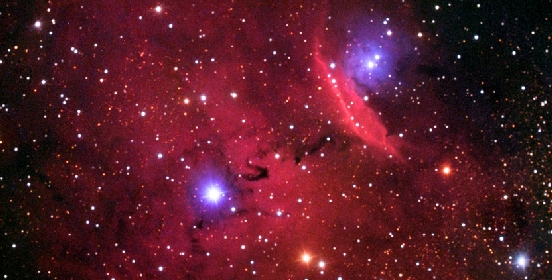

Mission Status Report #51 Star Date: November 1, 2001
FUSE Science Moves to the Forefront!Caption: The space between stars is not entirely empty! In many regions, clouds of gas and dust lurk nearly undetected. Where such clouds of gas and dust are located near hot, young stars, such as in this picture of NGC 6559, the gas glows or the dust can be seen as dark lanes against a brighter background. FUSE can detect such material even if it is invisible in such a picture by looking for absorption from this material in the far-ultraviolet light spectrum. Such indirect studies of hot and cold material in the Interstellar Medium" is a major part of what the FUSE satellite does. (Photo courtesy of Robert Gendler. See October 23, 2001.) (Click image above to see larger version.)
Hello World, All continues to go extremely well on the FUSE project. All systems are nominal, including the spacecraft, science instrument, and ground systems performance. As FUSE continues operations during the primary scientific mission, over three-quarters of a million seconds of on-target observing time is being obtained each month. These data are processed at Johns Hopkins and then archived at the Multi-Mission Archive at Space Telescope (MAST), where the data can be downloaded by astronomers from all over the world. The wheels of science sometimes grind slowly. The data sets produced by FUSE are themselves quite complex to work with, and interpretting what these data mean can also be challenging. We are please by the results coming out so far and there are many more on the way, but these are literally the tip of the iceberg! There is so much more to come! During the week of October 22, 2001, the FUSE Science Team met in Baltimore. (This is the so-called "Principal Investigator" science team--the group of scientists who proposed the FUSE mission to NASA. Averaged over the three years of the primary science mission, this team of scientists receives about 43% of the observing time, much of which has already been performed.) Each project leader reported on the results from their project area, and the results were truly impressive! From active galaxies to cool stars to hot stars to various programs on understanding cold and hot gas in interstellar space, it is clear that the FUSE mission is providing bold new insights into the universe around us. But it will take time for these results to make their way out into the professional literature. And this is only a fraction of the total FUSE effort! Over 50% of the time with FUSE is used to observe targets for Guest Investigators--scientists from the astronomical community selected by NASA to use the capabilities of FUSE for their own science projects. Since many of these people are university and college professors and the like, they also have limited time to pursue their research interests and get their results into publications. Many of these results are discussed first at meetings such as hosted bi-annually by the American Astronomical Society. To help get the word out about FUSE science results, the FUSE project is holding a FUSE Science Workshop on the Johns Hopkins campus March 20-22, 2002. This will be an opportunity for anyone working on FUSE-related science projects to come together, present their results, and discuss them with other scientists who may work in a similar or completely different field. This kind of cross-fertilization is common in astronomy and often results in new insights either about the data themselves or the interpretation of them. We encourage all FUSE scientists to consider attending this important meeting. (Watch the FUSE home page for details!) Elsewhere on the project, plans are well underway for "Cycle 3", or the third year of science operations, which begins officially on Dec. 1, 2001. NASA has recently announced the results of the latest round of proposal requests, and revised inputs to support those observations are being processed into the planning system. As long as our satellite remains healthy, we will continue to reap the benefits of this astronomical workhorse in orbit.
Reported by: Bill Blair, Chief of Observatory Operations
|
